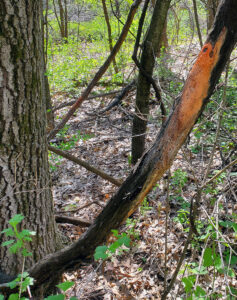
Common teasel in bloom. The flowerheads of teasel species are distinct, unusually large, stiff and sturdy. / Photo Credit: Steve Dewey, Utah State University, Bugwood.org
By Erika Segerson-Mueller, DNR Invasive Plant Program Specialist, Oshkosh Service Center
Erika.SegersonMueller@wisconsin.gov or 715-492-0391
Two species of teasel are present in Wisconsin: common teasel (Dipsacus fullonum) and cut-leaved teasel (Dipsacus lacinatus). Although they are known today as invasive plants, their Latin names speak to a useful history.
The species name of common teasel (fullonum) comes from “to full,” a step in woolen clothmaking that involves using water and agitation. Teasels, native to Europe, were introduced to North America in the 1700s to be used in this manner by textile processors. The stiff and sturdy flower heads of teasel were used to comb the surface of damp cloth to give it a fluffier finish. Continue reading “Teasing Out Invasive Teasels”

